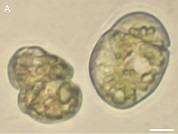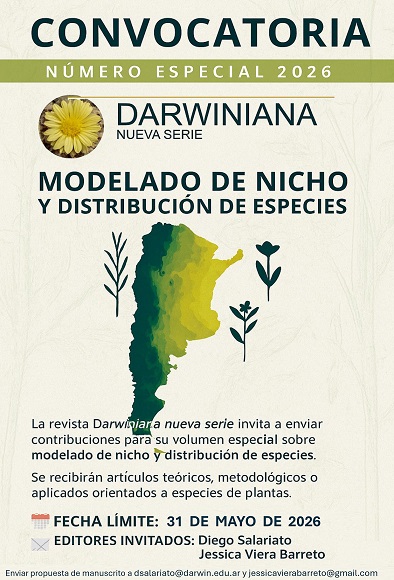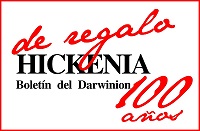Primer registro del género Togula (Gymnodiniales, Dinophyceae) y de la especie T. jolla para aguas costeras del Sudoeste del Océano Atlántico
DOI:
https://doi.org/10.14522/darwiniana.2024.121.1181Palabras clave:
aguas costeras del Sudoeste del Océano Atlántico, Argentina, caracterización morfológica y molecular, cultivos, filogenia, gimnodinioides, primer reporte, TogulaResumen
En el marco de un programa de monitoreo de fitoplancton y biotoxinas implementado desde 2008 en aguas marinas costeras de la Provincia de Buenos Aires (Argentina), un dinoflagelado gimnodinioide, fotosintético, fue aislado de una muestra colectada en Santa Teresita, estableciéndose la cepa LPCc007. La cepa fue identificada como perteneciente al género Togula con microscopía óptica con base en los siguientes caracteres distintivos: morfología de la célula dorso-ventralmente aplanada, y curso del cingulum, altamente asimétrico, descendente, con sus finales desplazados por cerca de uno a dos tercios de la longitud total de la célula y unidos por un surco intercingular oblicuo. El análisis morfológico comparativo entre las células vegetativas móviles de la cepa aislada y las tres especies del género descriptas hasta la fecha no reveló diferencias significativas que permitieran determinarla a nivel específico. En cambio, el patrón de desarrollo de surcos longitudinales en el hipocono de células a punto de sufrir mitosis observado en la cepa estudiada, concuerda perfectamente con el descrito para T. jolla como un carácter diferencial. La identificación morfológica fue consistente con la filogenia basada en LSU ADNr (D1-D2) que mostró la agregación de la secuencia en el clado molecular correspondiente a T. jolla. Este es el primer reporte del género Togula y de la especie T. jolla para Argentina y aguas costeras del Sudoeste del Océano Atlántico.
Citas
Borchhardt, N.; N. Chomérat, G. Bilien, F. Zentz, L. Rhodes, S. A. Murray & M. Hoppenrath. 2021. Morphology and molecular phylogeny of Bindiferia gen. nov. (Dinophyceae), a new marine, sand dwelling dinoflagellate genus formerly classified
within Amphidinium. Phycologia 60: 631-643. DOI: https://doi.org/10.1080/00318884.2021.1978040.
Daugbjerg, N.; G. Hansen, J. Larsen & Ø. Moestrup. 2000. Phylogeny of some of the major genera of dinoflagellates based on ultrastructure and partial LSU rDNA sequence data, including the erection of three new genera of unarmoured dinoflagellates. Phycologia 39: 302-317. DOI: https://doi.org/10.2216/i0031-8884-39-4-302.1.
Escarcega-Bata, A. J.; M. C. Ruiz-de la Torre, M. L. Nuñez Resendiz, L. M. Enriquez-Paredes, K. M. Dreckmann & A. Sentíes. 2021. Molecular assessment of athecate dinoflagellates of the Order Gymnodiniales (Dinophyceae) in Todos Santos Bay, Baja
California México. American Journal of Plant Sciences 12: 1926-1944. DOI:
https://doi.org/10.4236/ajps.2021.1212133.
Fensome, R. A.; F. J. R. Taylor, G. Norris, W. A. S. Sarjeant, D. I. Wharton & G. L. Williams. 1993. A classification of living and fossil dinoflagellates. Micropaleontology, Special Publication 7. Hanover, Pennsylvania: Sheridan Press.
Flø Jørgensen, M. F.; S. Murray & N. Daugbjerg. 2004a. Amphidinium revisited. I. Redefinition of Amphidinium (Dinophyceae) based on cladistic and molecular phylogenetic analyses. Journal of Phycology 40: 351-365. DOI: http://doi.org/10.1111/j.1529-8817.2004.03131.x.
Flø Jørgensen, M. F.; S. Murray & N. Daugbjerg. 2004b. A new genus of athecate interstitial dinoflagellates, Togula gen. nov., previously encompassed within Amphidinium sensu lato: Inferred from light and electron microscopy and phylogenetic analyses of partial large subunit ribosomal DNA sequences. Phycological Research 52: 284-299. DOI: https://doi.org/10.1111/j.1440-183.2004.00352.x.
Gómez, F.; D. Moreira & P. López-García. 2011. Avances en el estudio de los dinoflagelados (Dinophyceae) con la filogenia molecular. Hidrobiológica 21: 343-364.
Guiry, M. D. 2012. How many species of algae are there? Journal of Phycology 48: 1057-1063. DOI: http://doi.org/10.1111/j.1529-8817.2012.01222.x.
Hoppenrath, M.; M. Elbrächter & G. Drebes. 2009. Marine phytoplankton. Selected microphytoplankton species from the North Sea around Helgoland and Sylt. Stuttgart: Kleine Senckenberg-Reihe 49.
Hoppenrath, M.; S. Murray, S. F. Sparmann & B. S. Leander. 2012. Morphology and molecular phylogeny of Ankistrodinium gen. nov. (Dinophyceae), a new genus of marine sand-dwelling dinoflagellates formerly classified within Amphidinium. Journal of Phycology 48: 1143-1152. DOI: http://doi.org/10.1111/j.1529-8817.2012.01198.x.
Horiguchi, T.; M. Tamura, K. Katsumata & A. Yamaguchi. 2012. Testudodinium gen. nov. (Dinophyceae), a new genus of sand-dwelling dinoflagellates formerly classified in the genus Amphidinium. Phycological Research 60: 137-149. DOI: https://doi.org/10.1111/j.1440-1835.2012.00645.x.
Huelsenbeck, J. P. & F. Ronquist. 2001. MRBAYES: Bayesian inference of phylogenetic trees. Bioinformatics 17: 754-755. DOI: http://doi.org/10.1093/bioinformatics/17.8.754.
Janouškovec, J.; G. S. Gavelis, F. Burki, D. Dinh, T. R. Bachvaroff, S. G. Gornik, K. J. Bright, B. Imanian, S. L. Strom, C. F. Delwiche, R. F. Waller, R. A. Fensome, B. S. Leander, F. L. Rohwe & J. F. Saldarriaga. 2016. Major transitions in dinoflagellate evolution unveiled by phylotranscriptomics. Proceedings of the National Academy of Sciences 114: E171-E180. DOI: https://doi.org/10.1073/pnas.1614842114.
Kumar, S.; G. Stecher, M. Li, C. Knyaz & K. Tamura. 2018. MEGA X: molecular evolutionary genetics analysis across computing platforms. Molecular Biology and Evolution 35: 1547-1549. DOI: http://doi.org/10.1093/molbev/msy096.
Larsen, J. 2002. Dinoflagelados atecados potencialmente toxígenos en el Cono Sur Americano, in Sar E. A., M. E. Ferrario & B. Reguera (eds.), Floraciones algales nocivas en el Cono Sur Americano, pp. 147-154. Madrid, España: Instituto Español de Oceanografía.
Larsen, J. & N. L. Nguyen (eds.). 2004. Potentially toxic microalgae of Vietnamese waters. Opera Botanica 140: 5-216.
Lenaers, G.; L. Maroteaux, B. Michot & M. Herzog. 1989. Dinoflagellates in evolution. A molecular phylogenetic analysis of large subunit ribosomal RNA. Journal of Molecular Evolution 29: 40-51. DOI: http://doi.org/10.1007/BF02106180.
Murray, S.; M. Flø Jørgensen, N. Daugbjerg & L. Rhodes. 2004. Amphidinium revisited. II. Resolving species boundaries in the Amphidinium operculatum species complex (Dinophyceae), including the descriptions of Amphidinium trulla sp. nov. and Amphidinium gibbosum comb. nov. Journal of Phycology 40: 366-382. DOI: http://doi.org/10.1046/j.1529-8817.2004.03132.x.
Nei, M. & S. Kumar. 2000. Molecular Evolution and Phylogenetics. New York: Oxford University Press.
Nézan, E.; R. Siano, S. Boulben, C. Six, G. Bilien, K. Chèze, A. Duval, S. Le Panse, J. Quéré & N. Chomérat. 2014. Genetic diversity of the harmful family Kareniaceae (Gymnodiniales, Dinophyceae) in France, with the description of Karlodinium gentienii sp. nov.: A new potentially toxic dinoflagellate. Harmful Algae 40: 75-91. DOI: https://doi.org/10.1016/j.hal.2014.10.006.
Nishimura, T.; H. Uchida, R. Noguchi, H. Oikawa, T. Suzuki, H. Funaki, C. Ihara, K. Hagino, S. Arimitsu, Y. Tanii, S. Abe, K. Hashimoto, K. Mimura, K. Tanaka, I. Yanagida & M. Adachi. 2020. Abundance of the benthic dinoflagellate Prorocentrum and the diversity, distribution, and diarrhetic shellfish toxin production of Prorocentrum lima complex and P. caipirignum in Japan. Harmful Algae 96: 101687. DOI: https://doi.org/10.1016/j.hal.2019.101687.
Orr, R. J. S.; S. A. Murray, A. Stüken, L. Rhodes & K. S. Jakobsen. 2012. When naked became armored: an eight-gene phylogeny reveals monophyletic origin of theca in dinoflagellates. PLoS ONE 7: e50004. DOI: https://doi.org/10.1371/journal.pone.0050004.
Ott, B. M.; R. W. Litaker, W. C. Holland & C. F. Delwiche. 2022. Using rDNA sequences to define dinoflagellate species. PLoS ONE 17: e0264143. DOI: https://doi.org/10.1371/journal.pone.0264143.
Price, D. C. & D. Bhattacharya. 2017. Robust Dinoflagellata phylogeny inferred from public transcriptome databases. Journal of Phycology 53: 725-729. DOI: https://doi.org/10.1111/jpy.12529.
Reñé, A.; C. T. Satta, E. Garcés, R. Massana, M. Zapata, S. Anglès & J. Camp. 2011. Gymnodinium litoralis sp. nov. (Dinophyceae), a newly identified bloom-forming dinoflagellate from the NW Mediterranean Sea. Harmful Algae 12: 11-25. DOI: https://doi.org/10.1016/j.hal.2011.08.008.
Richlen, M. L. & P. H. Barber. 2005. A technique for the rapid extraction of microalgal DNA from single live and preserved cells. Molecular Ecology Notes 5: 688-691. DOI: http://doi.org/10.1111/j.1471-8286.2005.01032.x.
Shah, M. R.; S. -J. An & J. -B. Lee. 2013. Presence of benthic dinoflagellates around coastal waters of Jeju Island including newly recorded species. Journal of Ecology and Environment 36: 347-370. DOI: http://doi.org/10.5141/ecoenv.2013.347.
Sparmann, S. F.; B. S. Leander & M. Hoppenrath. 2008. Comparative morphology and molecular phylogeny of Apicoporus n. gen.: A new genus of marine benthic dinoflagellates formerly classified within Amphidinium. Protist 159: 383-399. DOI: https://doi.org/10.1016/j.protis.2007.12.002.
Tamura, K. & M. Nei. 1993. Estimation of the number of nucleotide substitutions in the control region of mitochondrial DNA in humans and chimpanzees. Molecular Biology and Evolution 10: 512-526. DOI: http://doi.org/10.1093/oxfordjournals.molbev.a040023.
Taylor, F. J. R. 1987. The Biology of Dinoflagellates. Botanical Monographs 21: 1-785.
Taylor, F. J. R.; M. Hoppenrath & J. F. Saldarriaga. 2008. Dinoflagellate diversity and distribution. Biodiversity and Conservation 17: 407-418. DOI: http://doi.org/10.1007/s10531-007-9258-3.
Yamada, N.; R. Terada, A. Tanaka & T. Horiguchi. 2013. Bispinodinium angelaceum gen. et sp. nov. (Dinophyceae), a new sand-dwelling dinoflagellate from the seafloor off Mageshima Island, Japan. Journal of Phycology 49: 555-569. DOI: http://doi.org/10.1111/jpy.12064.

Descargas
Publicado
Cómo citar
Número
Sección
Licencia

A partir de 2012, esta obra está licenciada bajo una Licencia Creative Commons Atribución-NoComercial 2.5 Argentina .
Cualquier obra derivada deberá estar previamente autorizada con nota escrita de los editores.







